Chapter: Digital Signal Processing : Frequency Transformations
Important Short Questions and Answers: Frequency Transformations
FREQUENCY TRANSFORMATIONS
1. Define DTFT.

2. Define Periodicity of DTFT.

3. Difference between DTFT and other transform.
The DFT
and the DTFT can be viewed as the logical result of applying the standard
continuous Fourier transform to discrete data. From that perspective, we have
the satisfying result that it's not the transform that varies; it's just the
form of the input:
·
If it is discrete, the Fourier transform becomes a
DTFT.
·
If it is periodic, the Fourier transform becomes a
Fourier series.
·
If it is both, the Fourier transform becomes a DFT.
4. Write about symmetry property of DTFT.
The
Fourier Transform can be decomposed into a real and imaginary or into even and
odd.
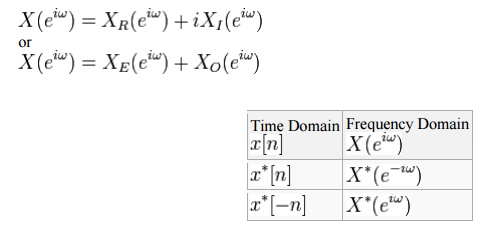
5. Define DFT pair.
The
sequence of N complex numbers x0, ..., xN−1 is transformed into the sequence of N complex numbers X0, ..., XN−1
by the DFT according to the formula:

6.How will you express IDFT interms of DFT.
A useful
property of the DFT is that the inverse DFT can be easily expressed in terms of
the (forward) DFT, via several well-known "tricks". (For example, in
computations, it is often convenient to only implement a fast Fourier transform
corresponding to one transform direction and then to get the other transform
direction from the first.) First, we can compute the inverse DFT by reversing
the inputs:

(As
usual, the subscripts are interpreted modulo N; thus,
for n = 0, we have xN − 0 = x0.) Second, one can also conjugate
the inputs and outputs:

Third, a
variant of this conjugation trick, which is sometimes preferable because it
requires no modification of the data values, involves swapping real and
imaginary parts (which can be done on a computer simply by modifying pointers). Define
swap(xn) as xn with its
real and imaginary parts swapped—that is, if xn = a + bi then
swap(xn) is b + ai.
Equivalently, swap(xn) equals
ix*n .
Then

7.Write about Bilateral Z transform.
The bilateral or two-sided Z-transform of a discrete-time signal x[n] is the function X(z) defined as

where n is an integer and z is, in general, a complex number:
z =
Aejφ (OR)
z = A(cosjφ +
sinjφ)
where A is the magnitude of z, and φ is the complex argument (also referred to as angle or phase) in radians
8. Write about Unilateral Z transforms.
Alternatively,
in cases where x[n] is defined only for n
≥ 0, the single-sided or unilateral Z-transform is defined as

In signal processing, this
definition is used when the signal is causal.
The region of convergence (ROC) is
the set of points in the complex plane for which the Z-transform
summation
converges.

10.Write about the output response of Z transform

A twiddle
factor, in fast
Fourier transform (FFT) algorithms, is any of the trigonometric constant
coefficients that are multiplied by the data in the course of the algorithm.
12. State the condition for existence of DTFT?
The
conditions are, If x(n)is absolutely summable then |x(n)|< If x(n) is not
absolutely summable then it should have finite energy for DTFT to exit.
13. List the properties of DTFT.
Periodicity,
Linearity, Time shift, Frequency shift, Scaling, Differentiation in frequency
domain, Time reversal, Convolution, Multiplication in time domain, Parseval’s
theorem
14. What is the DTFT of unit sample?
The DTFT
of unit sample is 1 for all values of w.
15. Define Zero padding.
The
method of appending zero in the given sequence is called as Zero padding.
16. Define circularly even sequence.
A
Sequence is said to be circularly even if it is symmetric about the point zero
on the circle. x(N-n)=x(n),1<=n<=N-1.
17. Define circularly odd sequence.
A
Sequence is said to be circularly odd if it is anti symmetric about point x(0)
on the circle
A
circularly folded sequence is represented as x((-n))N. It is obtained by
plotting x(n) in clockwise direction along the circle.
19. State circular convolution.
This
property states that multiplication of two DFT is equal to circular convolution
of their sequence in time domain.
20. State parseval’s theorem.
Consider
the complex valued sequences x(n) and y(n).If
x(n) - > X(k), y(n)ÆY(k) then
x(n)y*(n)=1/N X(k)Y*(k)
21. Define Z transform.
The Z
transform of a discrete time signal x(n) is denoted by X(z) and is given by
X(z)= x(n)Z-n.
22. Define ROC.
The value
of Z for which the Z transform converged is called region of convergence.
23. Find Z transform of x(n)={1,2,3,4}
x(n)=
{1,2,3,4}
X(z)=
x(n)z-n
=1+2z-1+3z-2+4z-3.
=1+2/z+3/z2+4/z3.
24. State the convolution property of Z transforms.
The
convolution property states that the convolution of two sequences in time
domain is equivalent to multiplication of their Z transforms.
25. What z transform of (n-m)?
By time
shifting property
Z[A
(n-m)]=AZ-m sinZ[ (n)] =1
26.State initial value theorem.
If x(n)
is causal sequence then its initial value is given by x(0)=lim X(z)
27.List the methods of obtaining inverse Z
transform.
Partial
fraction expansion.
Contour
integration
Power
series expansion
Convolution.
28. Obtain the inverse z transform of
X(z)=1/z-a,|z|>|a|
Given
X(z)=z-1/1-az-1
By time
shifting property X(n)=an.u(n-1)
1,
Determine the 8-Point DFT of the Sequence x(n)={1,1,1,1,1,1,0,0}
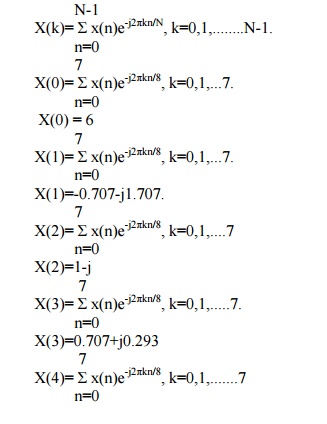

2,
Determine the 8-Point DFT of the Sequence x(n)={1,1,1,1,1,1,1,1}
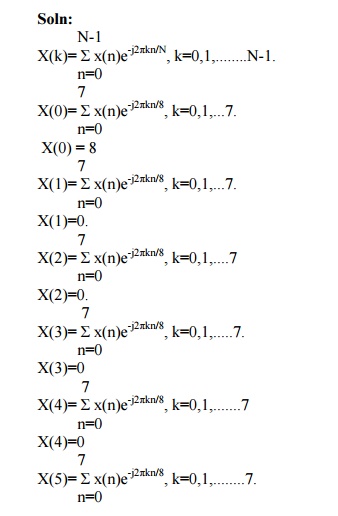
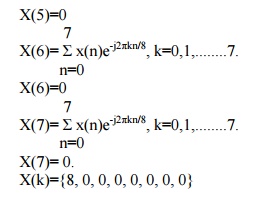
3,
Determine the 8-Point DFT of the Sequence x(n)={1,2,3,4,4,3,2,1}
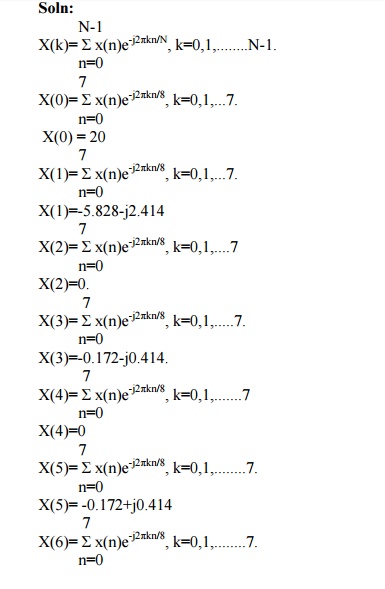

4,
Determine the 8-Point IDFT of the Sequence x(n)={5,0,1-j,0,1,0,1+j,0}
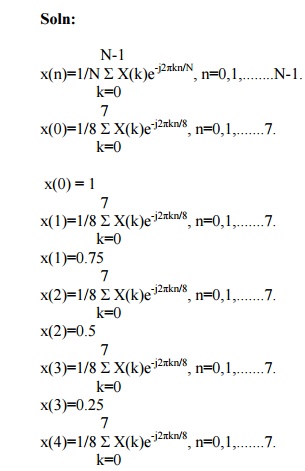
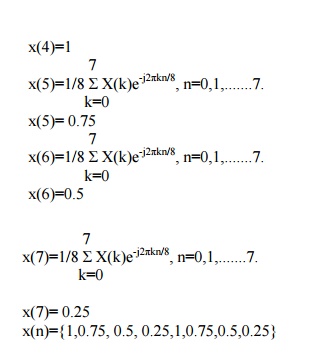
GLOSSARY:
The Transform that used to analyze the signals or
systems Characteristics in frequency domain , which is difficult in case of
Time Domain.
Laplace
Transform:
Laplace Transform is the basic continuous
Transform. Then it is developed to represent the continuous signals in
frequency domain.
Discrete
Time Fourier Transform:
For analyzing the discrete signals, the DTFT
(Discrete Time Fourier Transform) is used. The output, that the frequency is
continuous in DTFT. But the Transformed Value should be discrete. Since the
Digital Signal Processors cannot work with the continuous frequency signals. So
the DFT is developed to represent the discrete signals in discrete frequency
domain.
Discrete
Fourier Transform:
Discrete Fourier Transform is used for transforming
a discrete time sequence of finite length “N” into a discrete frequency
sequence of the same finite length “N”.
Periodicity:
If a discrete time signal is periodic then its DFT
is also periodic. i.e. if a signal or sequence is repeated after N Number of
samples, then it is called periodic signal.
Symmetry:
If a signal or sequence is repeated its waveform in
a negative direction after “N/2” number of Samples, then it is called symmetric
sequence or signal.
Linearity:
A System which satisfies the superposition
principle is said to be a linear system. The DFT have the Linearity property.
Since the DFT of the output is equal to the sum of the DFT’s of the Inputs.
Fast Fourier
Transform:
Fast Fourier Transform is an algorithm that
efficiently computes the discrete fourier transform of a sequence x(n). The
direct computation of the DFT requires 2N2 evaluations of
trignometric functions. 4N2 real multiplications and 4N(N-1) real
additions.
Related Topics